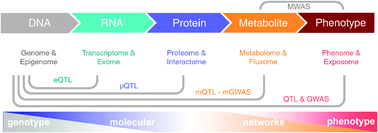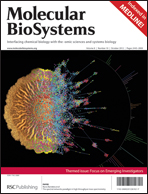Metabolome 2.0: quantitative genetics and network biology of metabolic phenotypes†
Abstract
The characterization of the metabolome has rapidly evolved over two decades, from early developments in analytical chemistry to systems biology. Metabolites and small molecules are not independent; they are organized in biochemical pathways and in a wider metabolic network, which is itself dependent on various genetic and signaling networks for its regulation. Recent advances in genomics, transcriptomics, proteomics and metabolomics have been matched by the development of publicly available repositories, which have helped shaping a new generation of integrative studies using metabolite measurements in molecular epidemiology and genetic studies. Although the environment influences metabolism, the identification of the genetic determinants of metabolic phenotypes (metabotypes) was made possible by the development of metabotype quantitative trait locus (mQTL) mapping and metabolomic genome-wide association studies (mGWAS) in a rigorous statistical genetics framework, deriving associations between metabolite concentrations and genetic polymorphisms. However, given the complexity of the biomolecular events involved in the regulation of metabolic patterns, alternative network biology approaches have also been recently introduced, such as integrated metabolome and interactome mapping (iMIM). This unprecedented convergence of metabolic biochemistry, quantitative genetics and network biology already has had a strong impact on the role of the metabolome in biomedical sciences, and this review gives a foretaste of its anticipated successes in eventually delivering personalized medicine.

- This article is part of the themed collection: Molecular BioSystems Emerging Investigators 2012

 Please wait while we load your content...
Please wait while we load your content...